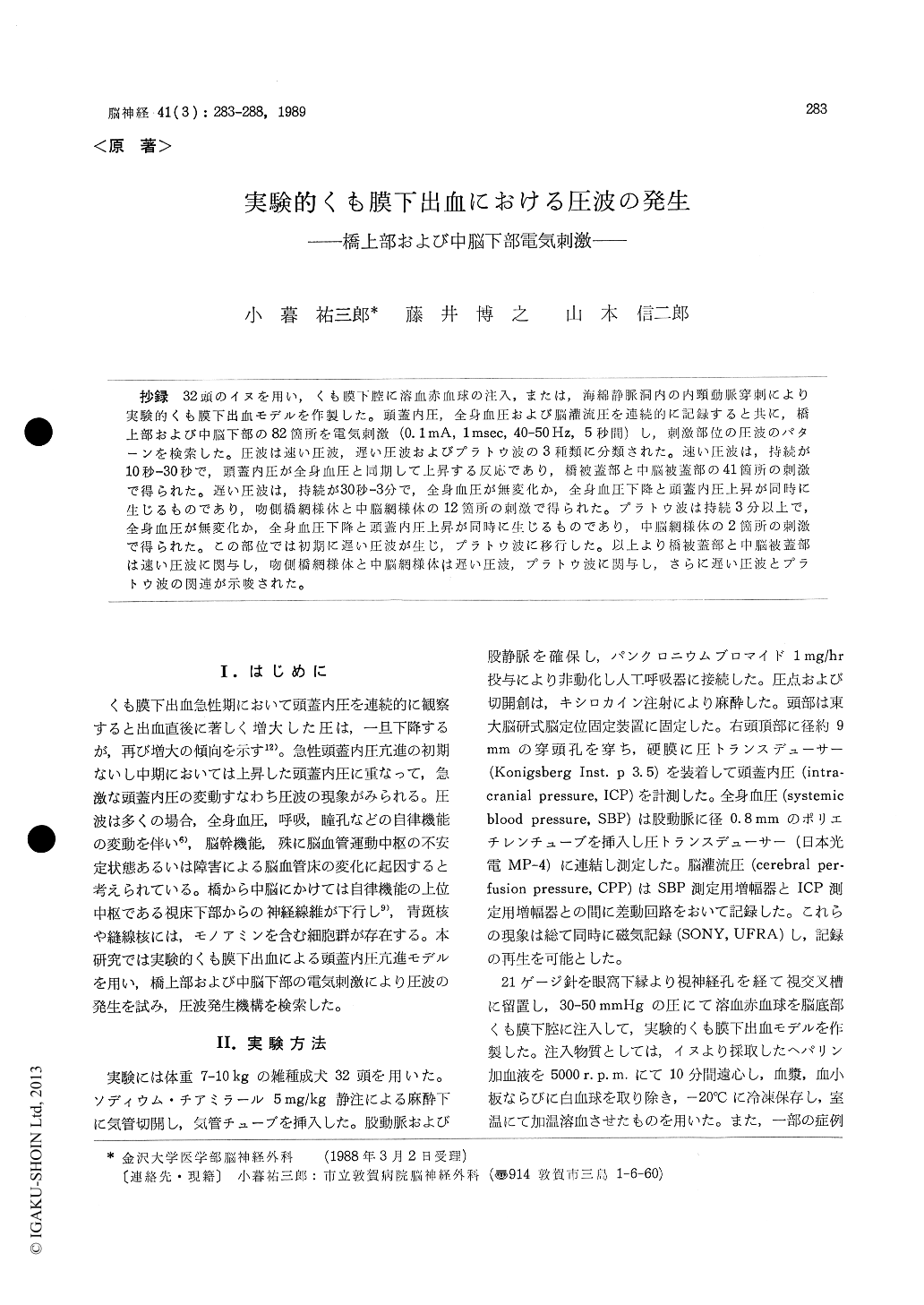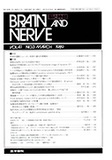Japanese
English
- 有料閲覧
- Abstract 文献概要
- 1ページ目 Look Inside
抄録 32頭のイヌを用い,くも膜下腔に溶血赤血球の注入,または,海綿静脈洞内の内頸動脈穿刺により実験的くも膜下出血モデルを作製した。頭蓋内圧,全身血圧および脳灌流圧を連続的に記録すると共に,橋上部および中脳下部の82箇所を電気刺激(0.1mA,1msec,40-50Hz,5秒間)し,刺激部位の圧波のパターンを検索した。圧波は速い圧波,遅い圧波およびプラトウ波の3種類に分類された。速い圧波は,持続が10秒−30秒で,頭蓋内圧が全身血圧と同期して上昇する反応であり,橋被蓋部と中脳被蓋部の41箇所の刺激で得られた。遅い圧波は,持続が30秒−3分で,全身血圧が無変化か,全身血圧下降と頭蓋内圧上昇が同時に生じるものであり,吻側橋網様体と中脳網様体の12箇所の刺激で得られた。プラトゥ波は持続3分以上で,全身血圧が無変化か,全身血圧下降と頭蓋内圧上昇が同時に生じるものであり,中脳網様体の2箇所の刺激で得られた。この部位では初期に遅い圧波が生じ,プラトウ波に移行した。以上より橋被蓋部と中脳被蓋部は速い圧波に関与し,吻側橋網様体と中脳網様体は遅い圧波,プラトウ波に関与し,さらに遅い圧波とプラトウ波の関連が示唆された。
Neuogenic mechanisms of pressure waves were investigated by means of electrical stimulation of the upper pons and the lower midbrain of 32 dogs in which subarachnoid hemorrhage had experimen-tally been made. The dogs were slightly anesthe-tized, immobilized and artificially respired.
After subarachnoid infusion of red blood cells, continuous recordings of systemic blood pressure (SBP), intracranial pressure (ICP) and cerebral perfusion pressure (CPP) were made simultaneously. At the stage of increased ICP, pressure waves were induced by electrical stimulation of the upper pons and the lower midbrain from 6 to 12 mm rostral to external auditory meatus. Stimulation parameters, i. e., intensity, duration and frequency, were kept constant at 0.1mA, 1 msec and 40-50 Hz, respec-tively, throughout experiments. The induced pressure waves were classified into three types : fast, slow and plateau waves. Fast waves had a duration of 10-30 sec, being associated with a marked increase in SBP. They were induced by stimulation of 41 points in various portions of the pontine and mesencephalic tegmentum. Slow waves had a duration of 30 sec to 3min, being associated with no change or a decrease in SBP. They were induced by stimulation of 12 points in the rostral pontine reticular formation and the mesencephalic reticular formation. Plateau waves had a duration of 3 min or more, being associated with no change or a decrease in SBP. They were induced by stimulation of 2 points in the mesencephalic reti-cular formation 2 mm lateral to the red nucleus, where slow waves had been induced at the early stage. These results suggest that the pontine and mesencephalic tegmentum are closely concerned with the production of fast waves ; the rostral pontine reticular formation and the mesencephalic reticular formation are concerned with that of slow waves and plateau waves. In adittion, plateau waves are suggested to have a relation to slow waves.

Copyright © 1989, Igaku-Shoin Ltd. All rights reserved.


